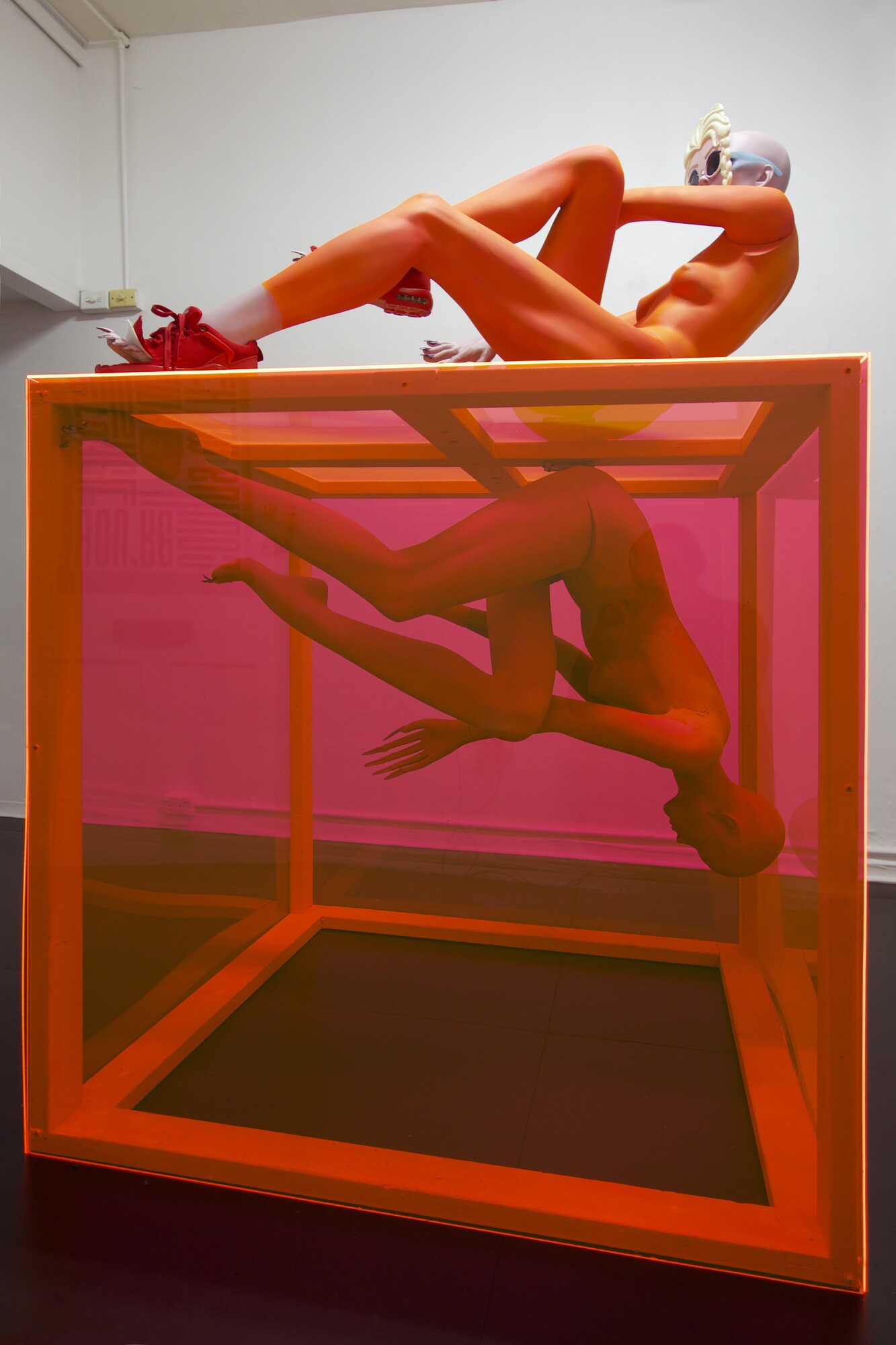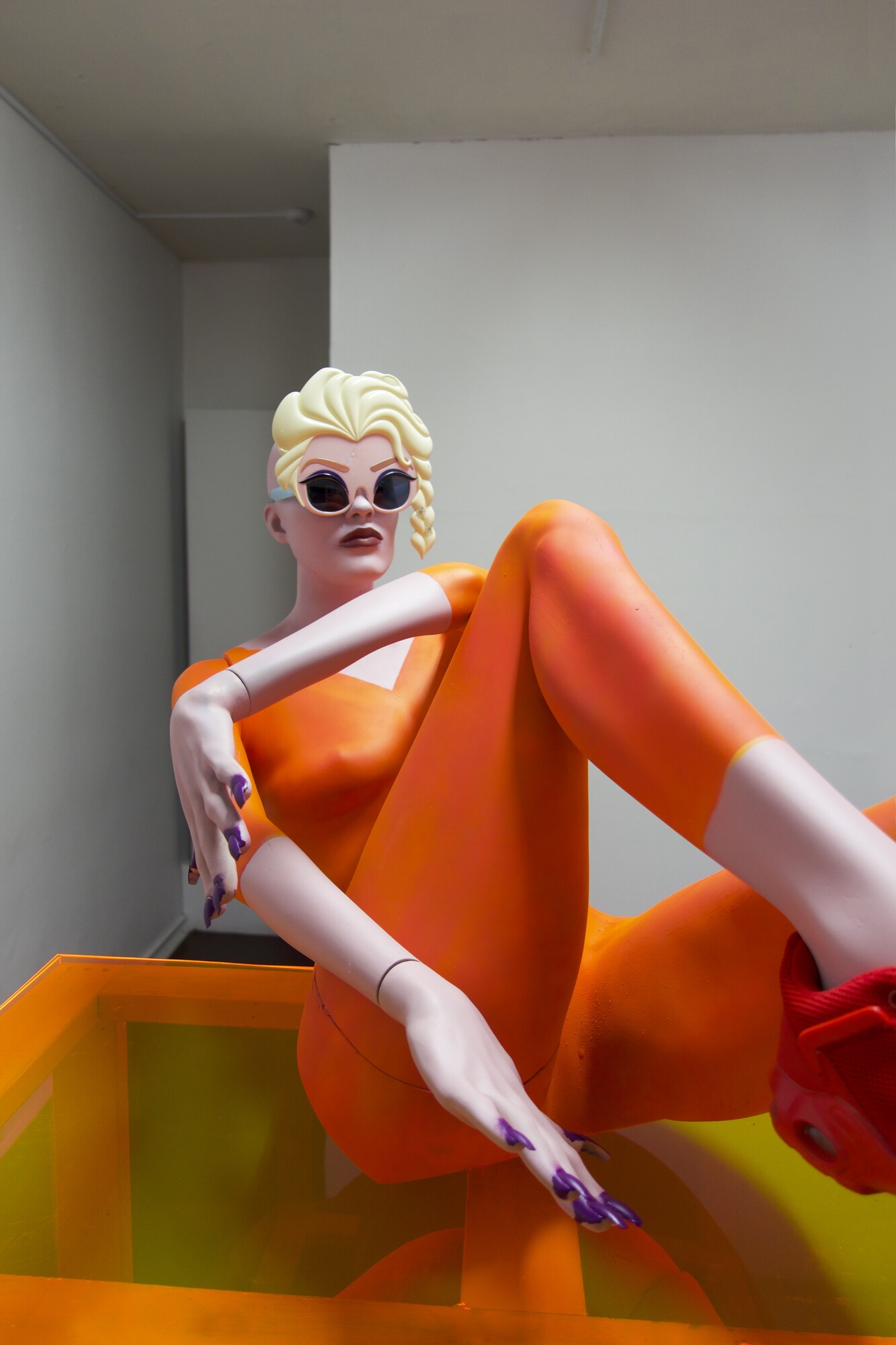Justene Williams, If I’m going to hell you’re coming with me
Gabrielle Chantiri
If I’m going to hell you’re coming with me appears as if it’s been brought to life exactly as it was in a dream, no restrictions or limits. This is a fiction of artmaking, of course, and yet Justene Williams’s exhibition shows Knulp to be a space where artists can engage the expectations of an audience and the fictions of artmaking. Inside the space, a rasping whisper says, “You know what paradise is? It’s a lie, a fantasy we create about people and places as we’d like them to be…I’ve been to Paradise, but I’ve never been to me.” Instead of Charlene, there’s a small screen on the floor showing a mannequin wearing a heart-shaped bustier. Her eyes are rubbed around the edges with black liner, and her large plum lips move as she speaks, but her face doesn’t crease or wrinkle. A second screen shows the mannequin lying in a foetal position, her body abstracting into swirling solids and fluid shapes. Layers of red and pink come up too, a kind of virtual womb space.

When I first entered Knulp, one of the gallery’s directors was there fixing the sound. There was no wall text or essay, so I felt lucky to enter on a glitch as it preceded my only clue for context. I was told the work was adapted from the artist’s production of Victory over the Sun, an opera by the Russian Futurists in 1913. Williams’s production was first performed at the Biennale of Sydney in 2016 and again at the National Gallery of Australia in 2022. Knulp is a sort of petri dish in comparison or a single eye with Williams’s sculpture as the pupil. The space is dominated by a large box with a mannequin on top and another inside it, suspended upside down. We can walk around it in circles like a horse in a tiny paddock, inquisition like with a light whip at our behinds.
Victory over the Sun is a story about comrades working together to bring the future by capturing the sun, a symbol of antiquated traditions like romance and sentimentality. The device used to ensnare the sun and so bring about the future was a box—an early iteration by the opera’s set and costume designer Kazimir Malevich of what was to become his famous Black Square (1915) painting. If we trot a smaller, tighter circle, we can see that the mannequin is wearing the eyes and forehead of the Disney princess from Frozen, her bodysuit looks to be spray painted, and she wears red sneakers with “Griffith College” stitched into the tongue. The mannequin’s feet stick out of the shoe with talon-like appendages, and I imagine these nails dexterously unpicking the lining from the inside of the shoe, like the two- point work of knitting needles, snipping threads until those glorious feet once cramped now stretch out and stiffen. Perhaps Griffith College is hell, and the sunshine coast is paradise? It is inhabited by effigies made of plastic and algorithms all melting under a proactive sun. If Victory over the Sun is manifest in these symbols, then they are resistant to conclusion or summary.

In an interview on her work No Mind, No Disco (2015), Williams was asked about the advantages of revisiting old works. It was an opportunity to re-edit, she said, to present ideas in different ways. The works don’t have to remain the same. She ended by saying, “This time I think I’ll get it right.” If I’m going to hell, you’re coming with me commits to what has come before, to a return. It does so not so much because previous articulations were wrong, bad, or immoral as that they just hadn’t been repeated.
The psychoanalyst Jacques Lacan describes an ethical imperative for the patient to “ speak well” (le bien dire), meaning to try as best as one is able to put one’s suffering and experiences into speech. In conversation with Lacan, an interviewer offered the following statement, “What is well conceived can be clearly stated,” which Lacan inverted to read, “What is well spoken, one conceives clearly, clearly means that it makes its way.” To speak well and so conceive of something clearly, we often have to repeat ourselves, to say a thing over and again, and this is where we might find the history of the Futurists in Williams’s work. In a review of the opera from 1913, music critic Alexander Koptiaev notes a “ childish culinary touch” in the libretto of Victory over the Sun. He writes:
Thus the Futurist will say, “The eyes of lunatics are overgrown with tea…,” “The camels of factories already threaten with fried fat,” “Walk street of millions, the ravioli will be Russian-style,” etc. The Futurist is without doubt a hungry being, first and foremost, and fills his imagination with images of edible things. At least it is clear what he wants here, and what he is after, but for us his search is generally a question mark. What is it you want with all this rubbish, my dear fellow?

Williams’s work commits to what has come before, not only in referencing avant-garde histories but also through this intuitive imperative, to fill the imagination with edible things, to turn desires into reality and reality into dreams. This is the gut of the Futurists, metabolising quickly and churning again, a fiction of endless autonomy. I went to the library to find catalogues on Justene Williams and found a small book of photographs she’d taken between 2000 and 2005, a series called Eye spy with my little eye – A gift from Justene Williams. The photos capture light or rather light-making shapes, the outline of a pool the colour of saffron, panels of sprinting blue, the blurred arc of a carnival ride and the excited squiggle that light makes when captured with a long exposure. In her thesis from 2001, she tells us, “The word photography comes from the Greek terms photos, which means ‘light,’ and graphein, which is ‘to draw.’ The process of recording images by the action of light on a light sensitive material is the basic understanding of what constitutes a photograph.” It’s like photography running around with a camera in its hands only to take a picture of itself, or as Anthony Gardner writes, this is Williams’s “literal attempt to get inside photography,” to make two dimensions into three dimensions.
Often this sort of work requires a suspension of disbelief, to use light-sensitive materials that turn the harsh light of a carnival ride into a blurry blossom, or to climb inside a photograph, making two dimensions into three. The Czech poet Viola Fischerová offers us one way of thinking about this. She writes:
A milk shop could sell its wares even in the dark
To begin living for oneself is greater than birth
Disbelief can be understood as indiscriminate attention
In any case, I’m advertising a house I no longer wish to live in.
A quick search of “milk shop” brings up creamy storefronts and shelves of milk cartons, containers wrapped in blue banners and coloured lids. Were you there you could grab one at random and be pretty happy with the taste in your tea or cereal. If disbelief can be understood as indiscriminate attention, then to live for oneself is perhaps to allow our attention to go where it will, to release ourselves from the stern hand that dictates what should and shouldn’t take our attention. Standing inside the space at Knulp, I can hear the sound of small birds, and I’m reminded there’s coffee next door. Looking out of the large window of the exhibition space, I see the road and the green oval just beyond it. Prams and bikes and people and dogs circumambulate under a sun splayed so thin over everything. If I’m going to hell you’re coming with me is an example of work that attempts to speak well, to conceive of something from the gut. In doing so, the fictions and expectations of art’s function and significance might be at play, and it’s in spaces like Knulp where attention might be suspended, and we’re invited to drift and drift again.
Gabrielle Chantiri is a writer from Sydney.


